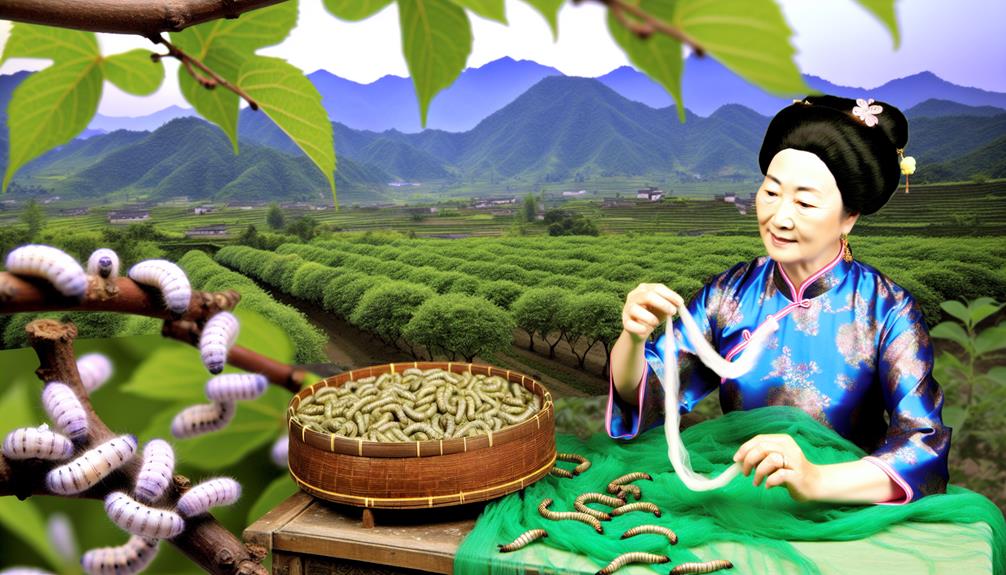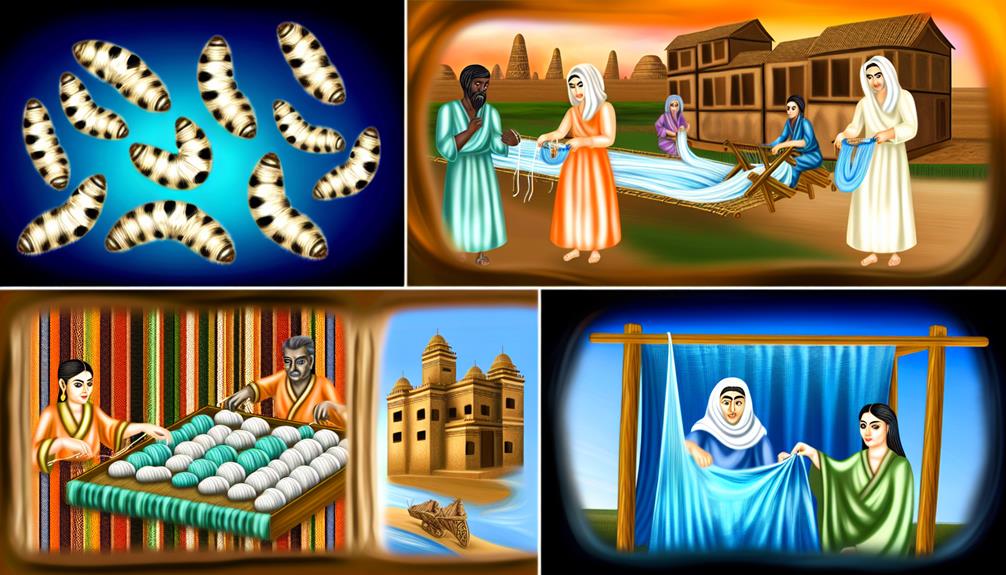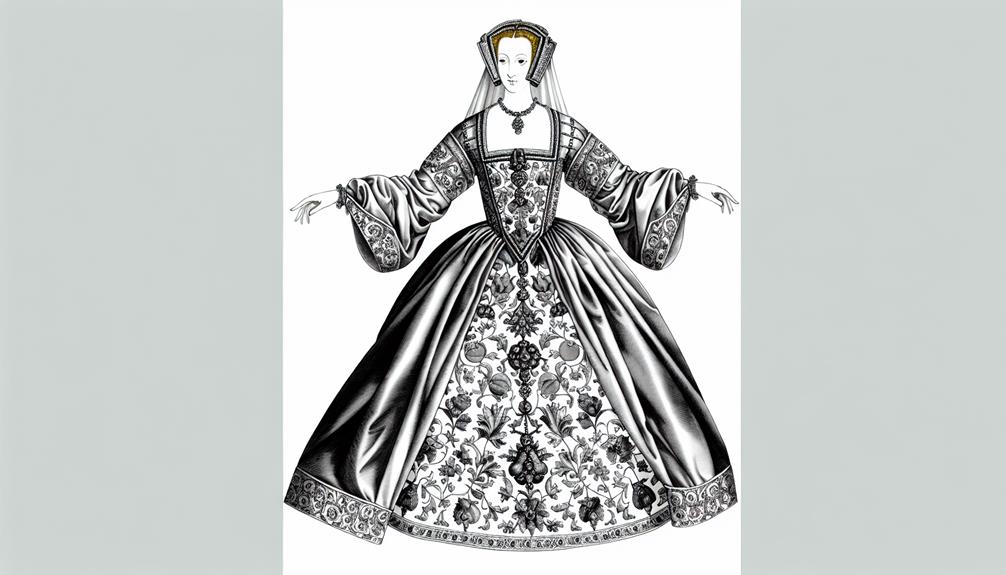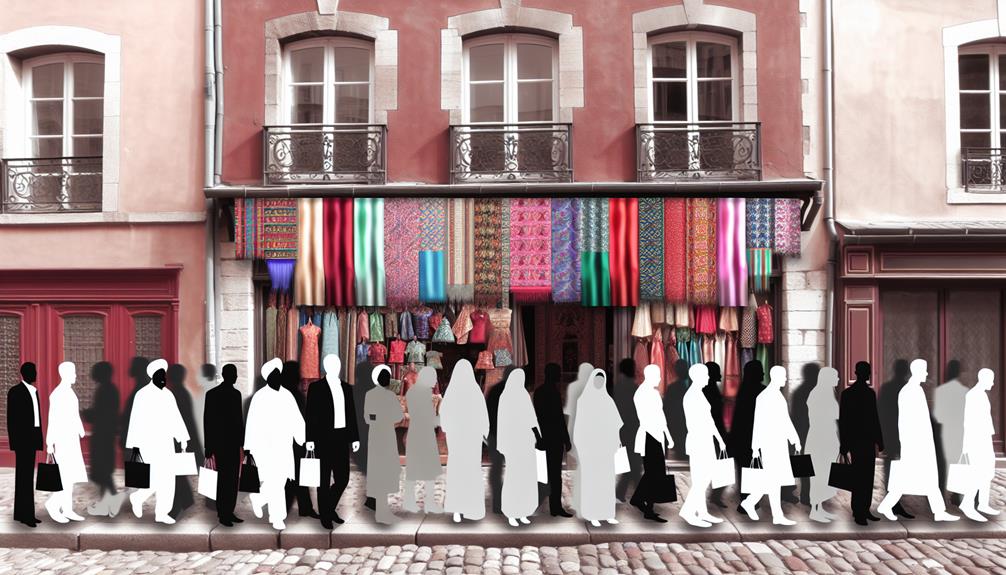Have you ever wondered about the History of Silk? It’s a theory that has intrigued historians for centuries.
As we embark on this exploration of the history of silk, we will uncover the secrets of its ancient beginnings, tracing its roots back to the opulent courts of Emperor Huangdi in China.
But there is much more to this tale than mere royal indulgence. We will travel along the legendary Silk Road, witness the evolution of silk as a luxury fabric, and discover how it found its way to France, where it became an integral part of the European fashion scene.
So, join us on this captivating journey as we unravel the mysteries of silk’s ancient cultural tradition.
History of Silk in Ancient China

Silk, a fabric that has captivated civilizations for centuries, originated in ancient China and was initially reserved exclusively for royalty and the elite. Empress Hi Ling Shih, who married Emperor Huangdi around 3,000 B.C., introduced silk to Chinese society.
Legends tell us that only the Emperor and his family were allowed to wear silk, with the Emperor wearing white silk inside the palace and yellow silk outside. Over time, the use of silk spread throughout Chinese culture, and Chinese silk exports reached East Asia.
China maintained control over the silk industry for some time until silk cultivation spread to countries like Persia and Europe through the Silk Road. This trade route network connected China and Asia to Europe and the Middle East, opening up trade with the West as early as 130 B.C.
The Silk Road continued until 1453 A.D. when the Ottoman Empire shut it down.
Spread of Silk Through the Silk Road
As we travel along the historical Silk Road, we witness the mesmerizing journey of silk as it weaves its way through various countries, spreading its luxurious allure and captivating the hearts of people across different cultures. The Silk Road, a vast trade route network connecting China and Asia to Europe and the Middle East, played a crucial role in the spread of silk. Allow us to illustrate this journey through a table:
| Country | Key Contributions | Cultural Impact |
|---|---|---|
| China | Silk production | Exquisite fashion and trade dominance |
| Persia | Silk cultivation | Integration into Persian culture |
| Europe | Trade with China | Introduction to luxury fashion |
| Middle East | Silk trade | Influence on Islamic art and fashion |
As silk made its way through the Silk Road, it enchanted people with its beauty and elegance, becoming a symbol of status and refinement. The allure of silk spread like wildfire, captivating the hearts of individuals from diverse backgrounds and cultures. It transcended boundaries, connecting people and fostering cultural exchange. Through the Silk Road, silk became a global phenomenon, transcending its origins in ancient China and becoming a symbol of liberation and sophistication.
Evolution of Silk as a Luxury Fabric

We continue our exploration of silk’s captivating journey along the Silk Road by delving into the remarkable evolution of this exquisite fabric, as it blossomed into a symbol of luxury and refined elegance.
Silk, once reserved for royalty, became accessible to the wealthy and merchants, and now to anyone through modern manufacturing techniques.
Japan emerged as a major producer of raw silk in the 19th century, followed by China reclaiming its status as the leader in silk production in the 1970s.
France established a national silk industry in Lyon, which became the center of European silk trade and a hub for fashion.
Today, Lyon is one of the world’s largest producers of modern-day silk, used in bridal wear, ties, scarves, bedding, upholstery, and even bicycle tires and surgical sutures. Lyon’s silk makers collaborate with top French clothing designers, including renowned brands like Hermès and Chanel, showcasing the enduring allure and versatility of silk.
Silk Industry in Lyon, France
Lyon, France, emerges as a vibrant hub for the silk industry, captivating the world with its exquisite craftsmanship and innovative designs. With a rich history dating back to 1466, Lyon has established itself as the center of the European silk trade, gaining total control over silk production. The city’s expertise in silk weaving is showcased in the masterpieces created by its skilled artisans. To highlight the significance of Lyon in the silk industry, let’s take a look at the following table:
| Lyon’s Contribution to the Silk Industry |
|---|
| Lyon’s Establishment as a Silk Center |
| Mechanical Looms Revolutionize Production |
| Lyon’s Role as a Major Silk Exporter |
Lyon’s silk industry has not only flourished in the realm of fashion, but has also expanded to various other sectors. Today, Lyon is one of the largest producers of silk worldwide, supplying the fabric for bridal and formal wear, ties and scarves, bedding, upholstery, and even bicycle tires and surgical sutures. Collaborating with renowned French clothing designers, Lyon’s silk makers have gained international recognition, with luxury brands like Hermès and Chanel sourcing their silk from Lyon. The city’s dedication to the art of silk production continues to inspire and liberate the imaginations of those who appreciate the beauty and versatility of this ancient fabric.
Silk’s Role in European Fashion

Continuing our exploration of the fascinating world of silk, we now turn our attention to the significant role this luxurious fabric has played in shaping European fashion.
- Silk became a symbol of wealth and status, allowing individuals to showcase their social standing and sophistication.
- European designers embraced silk, using it to create exquisite gowns, dresses, and suits that exuded elegance and refinement.
- Silk’s smooth and lustrous texture made it the perfect choice for flowing garments that accentuated the body’s natural curves.
- The lightweight nature of silk made it ideal for creating delicate and intricate designs, adding a touch of femininity and grace to European fashion.
Silk’s introduction into European fashion revolutionized the industry, bringing a sense of opulence and luxury to clothing that had never been seen before. As silk became more accessible, it allowed individuals of all backgrounds to indulge in the beauty and allure of this magnificent fabric, liberating them from the confines of societal restrictions.
Lyon: The Silk Capital of the World
As we delve into the captivating world of silk, one city stands out as the unrivaled epitome of silk production – Lyon, the vibrant and bustling Silk Capital of the World.
Nestled in the picturesque Rhône-Alpes region of France, Lyon has a rich history dating back to the 15th century when King Louis XI established a national silk industry here. Since then, Lyon has flourished as the center of the European silk trade, with a particular focus on fashion.
The city’s skilled artisans and innovative designers have made Lyon renowned for its exquisite silk creations. Today, Lyon continues to be at the forefront of the global silk industry, producing a wide range of silk products, from bridal and formal wear to ties, scarves, and even bicycle tires and surgical sutures.
Its collaboration with top French clothing designers and the use of Lyon silk by prestigious brands like Hermès and Chanel further solidify its status as the unrivaled Silk Capital of the World.
Modern Uses of Silk in France

Silk, a luxurious and versatile fabric, finds a multitude of modern uses in France. It isn’t just restricted to the realm of fashion and haute couture. Here are some of the ways silk is utilized in contemporary French society:
- Bridal and formal wear: Silk’s lustrous sheen and delicate drape make it a popular choice for wedding dresses, evening gowns, and other special occasion garments.
- Ties and scarves: Silk neckties and scarves are timeless accessories that add a touch of elegance to any outfit.
- Bedding: Silk sheets and pillowcases are prized for their softness and hypoallergenic properties, providing a luxurious and comfortable sleep experience.
- Upholstery and wall hangings: Silk fabrics are used to create stunning upholstery for furniture and to adorn walls with intricate tapestries, adding a touch of opulence to interior decor.
In addition to these traditional uses, silk has also found its way into modern applications such as bicycle tires and surgical sutures. Collaborating with top French clothing designers, silk makers in Lyon, one of the world’s largest producers of silk, continue to push the boundaries of silk’s versatility. Renowned fashion brands like Hermès and Chanel rely on the exquisite silk from Lyon to create their iconic designs.
With its diverse applications, silk remains a symbol of liberation and refinement in France.
Silk Collaboration With French Designers
Renowned for its versatility and timeless appeal, silk has seamlessly woven its way into the creative realm of French designers, becoming an integral part of their artistic collaborations. The collaboration between French designers and silk makers in Lyon has resulted in stunning creations that embody both elegance and innovation. These collaborations have not only showcased the extraordinary craftsmanship of the Lyon silk industry but have also brought a touch of luxury to the world of fashion.
Here is a visual representation of some of the notable collaborations between French designers and Lyon silk makers:
| Designer | Collaboration | Result |
|---|---|---|
| Christian Dior | Silk scarves featuring intricate floral patterns | Timeless accessories that add a touch of sophistication to any outfit |
| Coco Chanel | Silk dresses with flowing silhouettes | Effortlessly chic designs that exude femininity |
| Yves Saint Laurent | Silk blouses adorned with vibrant prints | Bold and expressive pieces that make a statement |
| Jean Paul Gaultier | Silk ties with unique and unconventional designs | Quirky and stylish accessories for the modern man |
These collaborations have not only elevated the status of silk as a luxurious fabric but have also showcased the creativity and craftsmanship of both the designers and the silk makers. Together, they have created a harmonious fusion of tradition and innovation, breathing new life into the ancient art of silk production.
Famous Brands and Silk From Lyon

Lyon’s rich history as a center for silk production has attracted famous brands from around the world, seeking the luxurious and high-quality silk that the city is renowned for. These brands recognize Lyon’s expertise and craftsmanship, and they value the heritage and tradition that comes with silk from Lyon.
When these brands choose to source their silk from Lyon, they aren’t only getting a beautiful and luxurious fabric, but they’re also supporting the local artisans and preserving a centuries-old tradition. Silk from Lyon isn’t just a fabric, it’s a symbol of elegance, sophistication, and timeless beauty.
Silk’s Versatility in Various Industries
In industries ranging from fashion to automotive, silk’s versatility shines through its ability to enhance and elevate various products with its luxurious texture and timeless beauty.
In the world of fashion, silk is used to create stunning garments that drape elegantly and exude sophistication. From bridal gowns to evening wear, silk adds a touch of opulence and refinement.
In the automotive industry, silk is utilized for its strength and durability. It’s woven into fabrics used for car interiors, providing a touch of luxury and comfort.
Silk is also found in the world of interior design, where it’s used for bedding, upholstery, and wall hangings. Its softness and sheen bring a touch of glamour to any space.
Additionally, silk’s versatility extends to unexpected industries such as bicycle tires and surgical sutures, where its strength and smoothness make it an ideal material.
Whether it’s in the realm of fashion, automotive, or beyond, silk continues to captivate with its ability to enhance and elevate various products.
Frequently Asked Questions
How Did the Ancient Chinese Discover the Process of Silk Production?
We discovered the process of silk production through ancient Chinese ingenuity and curiosity. The exact details of how it was first discovered remain a mystery, but according to legend, Empress Hi Ling Shih was the one who stumbled upon a silkworm cocoon. Intrigued, she unraveled the thread and realized its potential.
Over time, the Chinese perfected the art of silk cultivation, from raising silkworms to spinning their delicate fibers into luxurious cloth. This discovery revolutionized the textile industry and brought about a cultural tradition that has endured for centuries.
What Were Some of the Challenges Faced by Silk Traders Along the Silk Road?
Some of the challenges faced by silk traders along the Silk Road were harsh weather conditions, bandit attacks, and difficult terrain. We’d to navigate through deserts, mountains, and dense forests, which made the journey long and treacherous.
Additionally, we’d to protect our precious cargo from thieves who sought to steal our valuable silk. Despite these challenges, the allure of silk and the potential for profit drove us to endure and conquer the Silk Road.
How Did Silk Become a Symbol of Luxury and Wealth in Different Cultures?
Silk became a symbol of luxury and wealth in different cultures due to its exquisite beauty and rarity. The intricate weaving techniques and shimmering appearance made it highly desirable.
Initially, silk was reserved for royalty and the wealthy elite, showcasing their status and power. As silk production spread, it became more accessible, but its association with luxury remained.
Today, silk continues to be a symbol of elegance and sophistication, used in various industries such as fashion, home decor, and even medicine.
What Were the Major Advancements in Silk Production in France During the 18th Century?
During the 18th century, major advancements in silk production took place in France. Lyon, the center of the European silk trade, played a key role.
King Louis XI established a national silk industry in Lyon in 1466, granting the city total control over silk production.
The introduction of mechanical looms revolutionized silk manufacturing, making it more efficient. By the 18th century, Lyon became a major exporter of French silk, with a focus on fashion.
These advancements propelled Lyon to become one of the world’s largest producers of silk.
Can You Provide Some Examples of Innovative Uses of Silk in Industries Other Than Fashion and Textiles?
Sure!
Silk has found innovative uses beyond fashion and textiles. For example, it’s used in the production of bicycle tires, thanks to its strength and durability.
Additionally, silk is widely utilized in the medical field, where it’s used to create surgical sutures due to its biocompatibility and ability to dissolve within the body.
These innovative applications of silk highlight its versatility and make it an invaluable material in various industries.
Conclusion
In conclusion, the history of silk is a captivating tale that spans centuries and continents.
From its origins in ancient China to its spread through the Silk Road, silk has enchanted societies around the world with its luxurious feel and intricate beauty.
The rise of silk production in France, particularly in Lyon, solidified the fabric’s place in European fashion.
Today, silk continues to be a versatile and cherished material, collaborating with French designers and making a lasting impact in various industries.
The legacy of silk as an ancient cultural tradition lives on, weaving its way through time.





